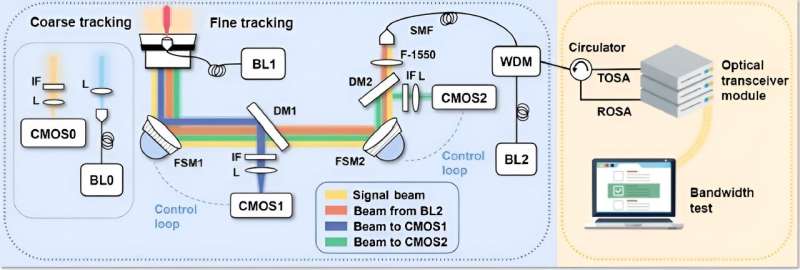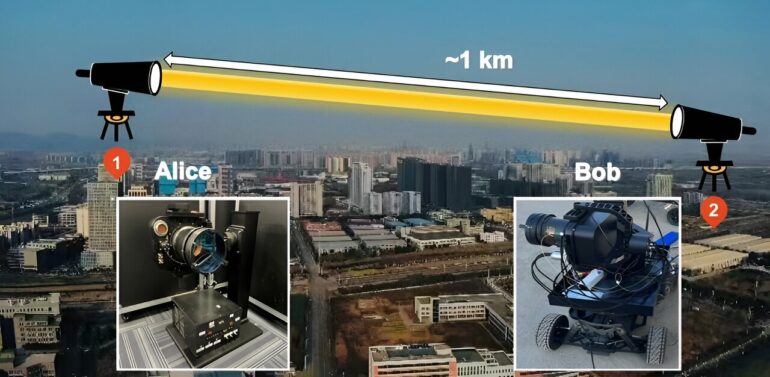In a world that relies on high-speed internet and seamless communication, the absence of a reliable fiber connection can be a significant hurdle. Fortunately, a cutting-edge technology known as free-space optical communication (FSO) offers a flexible solution for field-deployable high-speed wireless communication in areas where fiber connections are unavailable.
FSO has garnered attention for its versatility across various scales of operation. On a global level, it plays a crucial role in establishing high-speed satellite internet projects like Starlink, ensuring global connectivity. At the ground level, particularly in low-altitude scenarios, FSO shines as an attractive option for last-mile connections, disaster recovery efforts, and military communications.
Miniaturized FSO system
In a significant technological leap, researchers from Nanjing University (NJU) have developed a miniaturized FSO system that promises to revolutionize high-speed wireless communication.
As reported in Advanced Photonics Nexus, this remarkable system achieved an astonishing communication bandwidth of 9.16 gigabytes per second (Gbps) over a 1-kilometer (km) link. What sets it apart is that it accomplishes such high FSO performance using readily available commercial fiber optical communication transceiver modules (no need for optical amplification).
The core of this miniaturized FSO system comprises a pair of FSO devices. Each FSO device is compact, measuring just 45 cm × 40 cm × 35 cm, with a weight of 9.5 kilograms and a power consumption of approximately 10 watts. Each houses an optical transceiver module, an acquisition, pointing, and tracking (APT) device, and its control electronics, all safely sealed within a box for rugged outdoor operation. The APT device stands out with its low-diffraction optical design and a highly efficient 4-stage closed-loop feedback control system.

FSO device design. L, lens; IF, interference filter; DM, dichroic mirror; WDM, wavelength division multiplexer; TOSA, transmitter optical subassembly module; ROSA, receiver optical subassembly module; CMOS, complementary metal oxide semiconductor; BL, beacon laser; and FSM, fast steering mirror system. © Liu, Zhang, et al., doi 10.1117/1.APN.2.6.065001.
The FSO system exhibits remarkable tracking capabilities, through the integration of multiple sensors and sophisticated algorithms, which enable automatic, fast, and highly accurate acquisition and fine tracking in just 10 minutes. This precision keeps the tracking error within an impressive 3 microradians (μrad), resulting in a low average link loss of just 13.7 decibels (dB) over the 1-km link. Such precision also eliminates the need for optical amplification. Remarkably, the FSO system can achieve bidirectional data rates averaging 9.27 Gbps over the 1-km link, using only commercial transceiver modules.
According to Zhenda Xie, professor at the NJU School of Electronic Science and Engineering and corresponding author for the Advanced Photonics Nexus article, “This work highlights the potential for achieving FSO using commercially available fiber optical transceiver modules.” Xie notes that the effective distance of 1 km may be extended; his team also tested the optical links at up to 4 km, where the average loss increased to 18 dB—likely due to a foggy test environment. “With better weather conditions and optical amplification, longer FSO can be expected,” Xie concludes.
The implications of this achievement are profound. This miniaturized FSO breakthrough unlocks the potential for high-speed wireless communication virtually anywhere, making connectivity happen even in the most challenging environments. As we look ahead, these devices are set to play a pivotal role in the future of FSO networks, offering plug-and-play configurations that can establish high-speed FSO channels in minutes.
This innovation addresses the growing need for field-deployable, high-speed wireless communication solutions, bridging the connectivity gap in a world where staying connected is more critical than ever.
More information:
Hua-Ying Liu et al, High-speed free-space optical communication using standard fiber communication components without optical amplification, Advanced Photonics Nexus (2023). DOI: 10.1117/1.APN.2.6.065001
Citation:
Miniaturized free-space optical breakthrough unlocks high-speed wireless communication anywhere (2023, October 17)



